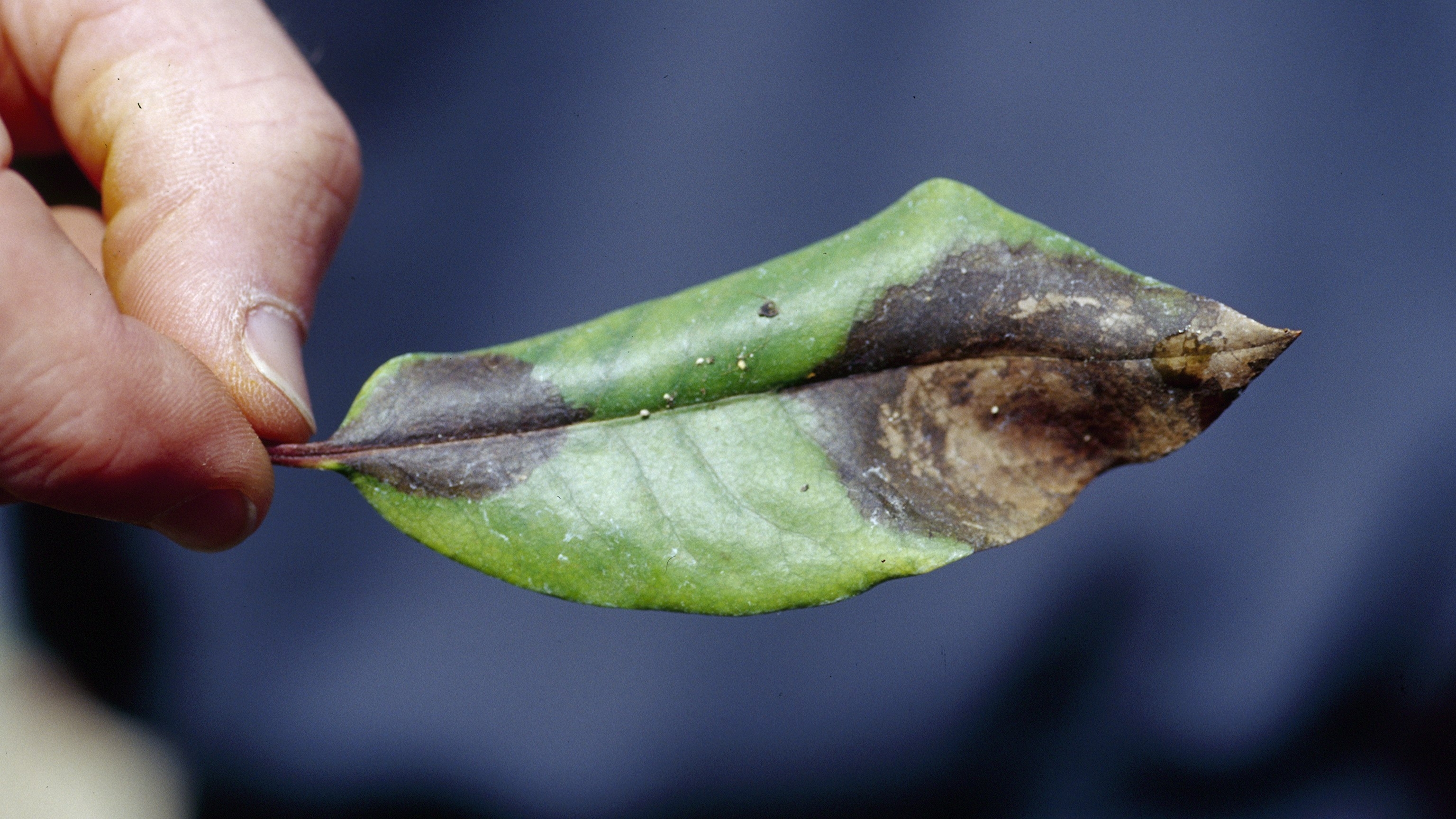Phytophthora ramorum

Phytophthora ramorum is an invasive plant pathogen that causes sudden oak death, ramorum blight, ramorum dieback, and Phytophthora canker diseases. There is no cure for the diseases caused by P. ramorum. Preventing the movement of infected plants and materials is the best way to protect our forests and landscape plants.
The water mold, P. ramorum, is an invasive pathogen that can infect over 100 plant species (319.67 KB). In coastal California and southern Oregon, P. ramorum causes sudden oak death, a disease which has killed millions of trees, primarily tanoak and coast live oak. The pathogen also causes twig and leaf diseases in several common nursery and landscape plants.
Symptoms vary on different types of plants. They can include:
- Trunk and branch cankers
- Brown to black lesions on leaves
- Twig dieback
An official diagnosis must be made by a trained professional and confirmed by laboratory testing. If you believe your plant may be infected with P. ramorum, please take the following actions:
- Check the list of plants that are susceptible to P. ramorum (319.67 KB) to see if your plant type is there.
- Compare the symptoms you're seeing to the California Oak Mortality Task Force Symptom Gallery.
- Report symptomatic plants to your State plant health director or State plant regulatory official.
P. ramorum can infect several native and non-native plant species, including many common nursery and landscape plants. To prevent disease spread:
- Only buy healthy plants from reputable sources.
- Do not move plants that appear sick or dying.
- Disinfest pruning and other gardening tools between plants.
- Because P. ramorum is a water mold that thrives in wet conditions, reduce standing water in your yard or garden and avoid overhead irrigation.
There is no treatment for P. ramorum infection. Prevention is the best defense.
Report Plant Pests and Diseases
Have you seen this pest or signs of pest damage? Immediately report your findings.
Find your State plant regulatory official
Find your State plant health director
Controlling Phytophthora ramorum
APHIS works to limit the spread of P. ramorum from regulated nurseries and quarantine areas to nurseries and areas that are free of the pathogen. We use both regulatory and non-regulatory strategies to achieve this goal. This includes public education, quarantines, inspections, surveys, and a compliance program.
Detection History
Sudden oak death was first reported in 1995 on a tanoak in Marin County, California. Since then, the P. ramorum pathogen has been confirmed on various native hosts in 16 counties in California (Alameda, Contra Costa, Del Norte, Humboldt, Lake, Marin, Mendocino, Monterey, Napa, San Francisco, San Mateo, Santa Clara, Santa Cruz, Solano, Sonoma, and Trinity) and 1 county in Oregon (Curry). Through ongoing surveys, APHIS continues to define the extent of the pathogen's distribution in the United States.
- Regulated Areas (172.13 KB)
- Regulated Articles (226.42 KB)
- Quarantined and Regulated Counties Map (2.69 MB) (April 2022)
- Federal Regulations, 7 CFR 301.92 - 301.92-12
- Federal Order: Restrictions on P. ramorum Host Plant Imports (42.79 KB)(4/18/2012)
- Canadian Food Inspection Agency Current Import Requirements
- Phytophthora ramorum Domestic Regulatory Program Manual (2.95 MB)
- List of Proven Hosts and Plants Associated with P. Ramorum (319.67 KB)
Diagnostic, Sampling, Response, and Survey Information
- Critical Control Point Assessment Template (285.88 KB)
- Diagnostics Work Instruction Table (231.89 KB)
- Current versions of all Work Instructions are available on the APHIS Laboratory Portal
- Potentially Actionable Suspect Sample (PASS) System (363.29 KB) (Revised 3/2024)
- Symptoms Associated With P. ramorum
- Nursery Survey Questionnaire (489.71 KB)
- PPQ Form 391 (364.31 KB)
- 2013 P. ramorum Farm Bill Nursery Survey Criteria (167.83 KB)
- National Plant Diagnostics Network
- Pest Risk Assessment (2.44 MB) (January 2008)
- National Quality Assurance Program Review Report (90.37 KB) (October 2009)
- National Program Review (198.38 KB) (December 2009)

